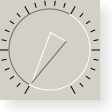QDial¶

Synopsis¶
Functions¶
def
initStyleOption(option)def
notchSize()def
notchTarget()def
notchesVisible()def
setNotchTarget(target)def
wrapping()
Slots¶
def
setNotchesVisible(visible)def
setWrapping(on)
Detailed Description¶

QDialis used when the user needs to control a value within a program-definable range, and the range either wraps around (for example, with angles measured from 0 to 359 degrees) or the dialog layout needs a square widget.Since
QDialinherits fromQAbstractSlider, the dial behaves in a similar way to aslider. Whenwrapping()is false (the default setting) there is no real difference between a slider and a dial. They both share the same signals, slots and member functions. Which one you use depends on the expectations of your users and on the type of application.The dial initially emits
valueChanged()signals continuously while the slider is being moved; you can make it emit the signal less often by disabling thetrackingproperty. ThesliderMoved()signal is emitted continuously even when tracking is disabled.The dial also emits
sliderPressed()andsliderReleased()signals when the mouse button is pressed and released. Note that the dial’s value can change without these signals being emitted since the keyboard and wheel can also be used to change the value.Unlike the slider,
QDialattempts to draw a “nice” number of notches rather than one per line step. If possible, the number of notches drawn is one per line step, but if there aren’t enough pixels to draw every one,QDialwill skip notches to try and draw a uniform set (e.g. by drawing every second or third notch).Like the slider, the dial makes the
QAbstractSliderfunctionsetValue()available as a slot.The dial’s keyboard interface is fairly simple: The left/up and right/down arrow keys adjust the dial’s
valueby the definedsingleStep, Page Up and Page Down by the definedpageStep, and the Home and End keys set the value to the definedminimumandmaximumvalues.If you are using the mouse wheel to adjust the dial, the increment value is determined by the lesser value of
wheelScrollLinesmultiplied bysingleStep, andpageStep.
- class PySide2.QtWidgets.QDial([parent=None])¶
- param parent:
Constructs a dial.
The
parentargument is sent to theQAbstractSliderconstructor.
- PySide2.QtWidgets.QDial.initStyleOption(option)¶
- Parameters:
option –
PySide2.QtWidgets.QStyleOptionSlider
Initialize
optionwith the values from thisQDial. This method is useful for subclasses when they need aQStyleOptionSlider, but don’t want to fill in all the information themselves.See also
- PySide2.QtWidgets.QDial.notchSize()¶
- Return type:
int
This property holds the current notch size.
The notch size is in range control units, not pixels, and if possible it is a multiple of
singleStep()that results in an on-screen notch size nearnotchTarget().By default, this property has a value of 1.
See also
- PySide2.QtWidgets.QDial.notchTarget()¶
- Return type:
float
This property holds the target number of pixels between notches.
The notch target is the number of pixels
QDialattempts to put between each notch.The actual size may differ from the target size.
The default notch target is 3.7 pixels.
- PySide2.QtWidgets.QDial.notchesVisible()¶
- Return type:
bool
This property holds whether the notches are shown.
If the property is
true, a series of notches are drawn around the dial to indicate the range of values available; otherwise no notches are shown.By default, this property is disabled.
- PySide2.QtWidgets.QDial.setNotchTarget(target)¶
- Parameters:
target –
double
See also
- PySide2.QtWidgets.QDial.setNotchesVisible(visible)¶
- Parameters:
visible – bool
This property holds whether the notches are shown.
If the property is
true, a series of notches are drawn around the dial to indicate the range of values available; otherwise no notches are shown.By default, this property is disabled.
- PySide2.QtWidgets.QDial.setWrapping(on)¶
- Parameters:
on – bool
This property holds whether wrapping is enabled.
If true, wrapping is enabled; otherwise some space is inserted at the bottom of the dial to separate the ends of the range of valid values.
If enabled, the arrow can be oriented at any angle on the dial. If disabled, the arrow will be restricted to the upper part of the dial; if it is rotated into the space at the bottom of the dial, it will be clamped to the closest end of the valid range of values.
By default this property is
false.
- PySide2.QtWidgets.QDial.wrapping()¶
- Return type:
bool
This property holds whether wrapping is enabled.
If true, wrapping is enabled; otherwise some space is inserted at the bottom of the dial to separate the ends of the range of valid values.
If enabled, the arrow can be oriented at any angle on the dial. If disabled, the arrow will be restricted to the upper part of the dial; if it is rotated into the space at the bottom of the dial, it will be clamped to the closest end of the valid range of values.
By default this property is
false.
© 2022 The Qt Company Ltd. Documentation contributions included herein are the copyrights of their respective owners. The documentation provided herein is licensed under the terms of the GNU Free Documentation License version 1.3 as published by the Free Software Foundation. Qt and respective logos are trademarks of The Qt Company Ltd. in Finland and/or other countries worldwide. All other trademarks are property of their respective owners.
